
The spongy moth, Lymantria dispar dispar (LDD), formerly known as European gypsy moth, is a non-native defoliating insect that feeds on a variety of tree species found in the Greater Toronto Area (GTA) and throughout North America. The City of Toronto’s management program focuses on controlling outbreak levels of spongy moth in areas with trees that are at risk of defoliation, typically oak dominant communities. Since spongy moth is firmly established in Toronto and North America, the complete removal of these insects is no longer a possibility.
Help manage spongy moth by following these Integrated Pest Management Strategy techniques.
Wearing long-sleeve shirts and protective equipment such as gloves and face masks or face coverings will help to minimize exposure to spongy moth hairs, silken threads, and shed skins, which can cause skin rashes and upper respiratory tract irritation in some people.
Toronto residents are encouraged to report any sightings of spongy moth through the City’s online reporting tool. The input from residents reporting the presence of this insect is important in coordinating monitoring efforts across the City.
311 can assist residents with submitting a report using the reporting tool. When contacting 311, please be prepared to give the exact address of the spongy moth sighting to submit a report through the tool.
City staff will use the information collected to determine the level of the infestation in specific areas by conducting egg mass surveys during the fall and winter seasons.
Carefully survey your property for egg masses and scrape them off surfaces into soapy water to destroy them. In addition to trees, egg masses can be found on eaves troughs, doorframes, under patio furniture, play structures and garden stones.
Egg masses can be located high up in trees. Be safe if trying to access anything up high, especially if using ladders. Some private tree care companies can be hired to provide this service at heights.
For severe infestations, apply a product that contains Btk to foliage at the early stage of caterpillar development when caterpillars just begin feeding. This is usually around mid-May. The pesticide must be ingested by the caterpillar to be effective.
For small trees and shrubs that you can reach, products like Safer® Brand Caterpillar Killer can be purchased at local garden supply stores.
For larger trees, it is recommended that you consult with a private arborist about pesticide injections.
Injections work for larger trees that can’t be sprayed from the ground or are too difficult to access. Pesticide injections are not recommended for evergreen or needle bearing trees such as spruce or pine.
Additional information about ground spraying and tree injections is available under the City’s Integrated Pest Management Strategy section of this web page.
Handpicking caterpillars is most effective on small newly planted trees, shrubs, and plants infested with spongy moth. If possible, gently shake the tree so caterpillars fall from leaves. Thoroughly inspect the remaining foliage, branches, and trunk for caterpillars and using gloves, pick them off your tree. Fallen and collected caterpillars should be placed and left to soak in soapy water to destroy them.
Once spongy moth caterpillars grow to about an inch (2.5 cm) in length by mid-June, they will move down the trunk to seek shelter from predators and heat. Reduce the number of caterpillars on the trees in your yard by trapping them.
Consult an arborist for treatment options or contact your local garden supply store for the availability of materials.
In an ongoing effort to lead an inclusive organization, the City of Toronto is transitioning away from the use of the term gypsy moth for the insect Lymantria dispar dispar, and will be using the term spongy moth moving forward. On March 2, 2022, the Entomological Society of America adopted spongy moth as the new common name for the spongy moth.
The spongy moth is an invasive insect from Europe that was accidentally introduced in North America in the 1860s during an attempt to rear an alternative silk-producing insect. Spongy moth caterpillars are 5 to 60 millimetres in length, dark and hairy, with five pairs of blue dots and six pairs of red dots on the back. They feed on a wide range of hardwood trees, as well as evergreen trees, but show a preference to oak trees.
Extreme spongy moth outbreaks have been associated with skin rashes and upper respiratory tract irritation in some people exposed to airborne spongy moth hairs, silken threads, or shed skins.
There is a potential for some people to develop minor skin irritations or rashes when they come in contact with these insects. If this is a concern, it is recommended that you try to avoid contact whenever possible.
Spongy moth is established in the northeastern U.S.A. and in regions of the eastern Canadian provinces. The spread of spongy moth across North America is attributed to the movement of the insect via infested wood or hitchhiking on vehicles. Public awareness could significantly reduce and limit the spread of spongy moth to new areas.
The Early Detection and Distribution Mapping System (EDDMapS) of Ontario will display the current range of the spongy moth.
The spongy moth caterpillar is known to feed on most species hardwood trees with the exception of ash, tulip-tree, American sycamore, London plane, catalpa, fir and cedar. Most healthy trees can withstand one to several years of severe defoliation by spongy moth. Under normal circumstances, defoliated trees should regrow their leaves by the end of July, depending on the weather conditions during the season.
Oak species, particularly white oaks, and Colorado spruce are very vulnerable to spongy moth feeding and can be killed in one season when a significant proportion of the foliage is consumed. Severe loss of leaves or needles can also stress trees and make them more susceptible to further harm from other insects, diseases and weather fluctuations. Evergreen species of trees, for example blue spruce and white pine, are particularly vulnerable once large portions of their needles are consumed by LDD caterpillars, they generally do not recover.
Spongy moths have three significant natural enemies:
The fungus and virus can be very effective at naturally controlling populations, however, they require a cool wet spring to be effective. The wasp can parasitize up to 30% of the eggs that are near the surface of an egg mass, but cannot reach the eggs in the center of the mass.
Spongy moth has four distinct developmental stages:
Egg masses remain secured to surfaces such as tree bark, outdoor furniture, landscape stones and vehicles and hatch to coincide with the warm weather and the opening of tree buds. Egg masses range in size from 2-8 cm long and can contain between 100-1000 eggs.
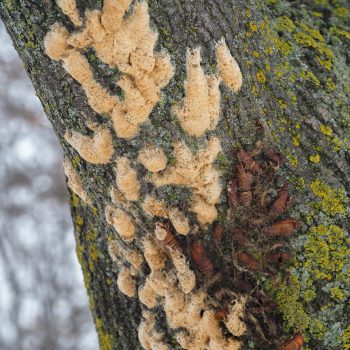
Newly hatched caterpillars are about half a centimetre long and dark in colour. The tiny caterpillars begin the climb up to the tree canopy, though if it is rainy they may stay put for several days. The caterpillar will either begin to feed on the newly flushed leaves or travel to a nearby tree though a method called “ballooning”, where they dangle from long silken threads at the end of branches and are carried away by the breeze. While their light bodies can travel several kilometres, they will typically be carried to the tree right next to them.
Spongy moth caterpillars grow and change in appearance over the span of one to two months. As they grow, they moult or shed their skin. By the fourth moult, the pairs of characteristic blue and red dots are visible on their back.
A single caterpillar can eat an average of one square meter of foliage. They continue to feed, moult, and feed until they are about six to seven centimetres long. Once they’ve finished feeding, they seek shelter to cocoon.
After the adult moth emerges, it leaves the empty cocoon behind. The female cocoon is larger than the male cocoon.
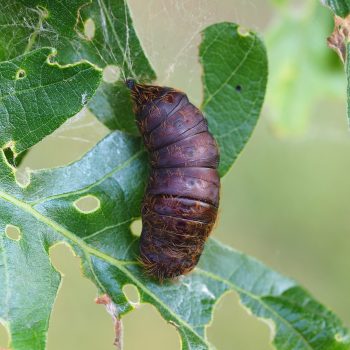
An adult spongy moth’s only function is to reproduce. Unlike other species of butterflies and moths, adult spongy moths do not eat anything. The female is larger than the male and is cream coloured. The female moths cannot fly. Instead, she uses pheromones to attract male moths. Male moths are smaller and brown in colour.
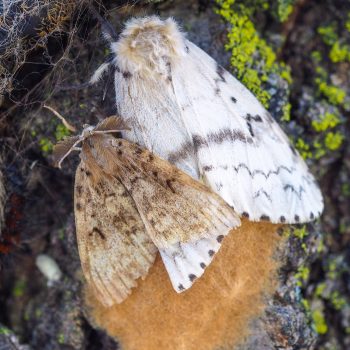
Spongy moth outbreaks may appear suddenly and may continue for two to five years in any one location. Natural control factors such as disease, parasites and predators eventually combine to cause a collapse of these outbreaks. Consecutive years of spongy moth at outbreak levels can cause severe defoliation which can lead to tree mortality and intervention may be required.
The spongy moth management program aims to control outbreak levels of spongy moth in areas with trees that are potentially at risk of severe defoliation or mortality if no action is taken. Eradication of spongy moth is not a realistic management objective since it is well established throughout North America.
To help manage infestations, the City will continue to use the Integrated Pest Management (IPM) Strategy. IPM is a sustainable approach to managing pests by combining biological, cultural, physical and chemical controls in a way that minimizes economic, health and environmental risks.
IPM aims to suppress pest populations to an acceptable level or threshold.
City staff conduct egg mass surveys in residential neighbourhoods, parks and natural areas to identify areas infested with spongy moth. Surveys are typically conducted in parts of the city with historic spongy moth infestations and in new areas where residents have reported spongy moth sightings. These surveys allow City staff to delineate the infested areas and to forecast spongy moth population levels for the following spring. City tree(s) with high numbers of egg masses that are at risk of being defoliated are candidates for treatment.
The City will prescribe different types of treatments depending on the infestation level, tree species, size of the tree, and its location. Each treatment has limitations, so a combination of control measures is essential for a successful control program. Treatments are to reduce the spongy moth’s population levels and to prevent severe canopy damage from occurring and tree mortality.
The physical removal of egg masses is an effective method of control for small to medium-sized, low-risk tree species, such as Norway maple, linden and honey locust, located on residential streets or City parks. City staff are equipped with vacuums attached to extension poles that are used to remove and collect the egg masses off of the tree. Egg masses collected this way are destroyed off-site to ensure they no longer pose a threat.
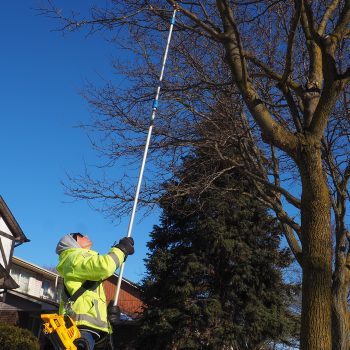
TreeAzin is a botanical injectable pesticide formulated with an extract of neem tree seeds that provides a treated tree with protection from spongy moth feeding for one season. When a caterpillar eats the leaves of a treated tree, the pesticide kills the insect by preventing it from growing any larger. This limits the amount of damage to the tree. High-risk trees – trees that are predicted to be severely defoliated – are generally selected for this treatment. The timing of treatments is essential for successful control.
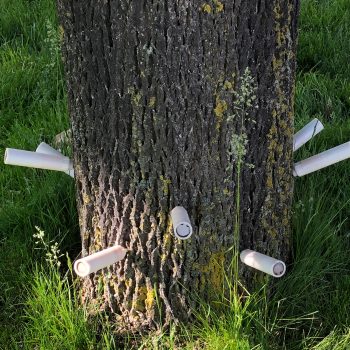
The City uses products that contain the active ingredient Bacillus thuringiensis subspecies kurstaki (Btk). This is a naturally occurring bacteria found in soil that can be sprayed onto the foliage of individual trees for spongy moth control. Ground spraying for spongy moth is a control often used in City parks to treat spruce trees since other methods have proven to be unsuccessful. The timing of these applications is extremely time sensitive as there is a very narrow treatment window for Btk applications. Because of this, the number of trees selected for this method of treatment is limited.
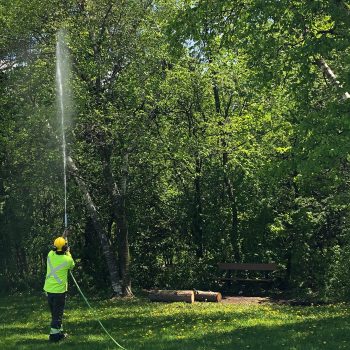
Aerial spraying to control spongy moth was last completed in spring 2022. Egg mass surveys are conducted in the fall and winter to determine if control measures are needed the following spring.
The City plans aerial spray programs when spongy moth outbreaks are severe and widespread across large areas of dense high-risk tree canopies, usually oak-dominated. Aerial sprays are only conducted when there is no other Integrated Pest Management control option available that would reduce the populations significantly enough to meet acceptable thresholds.
During the months following the treatments, City staff conduct post-treatment monitoring surveys to assess the level of feeding on treated trees/areas. Treated trees are inspected for signs and levels of feeding activity and caterpillar abundance. These areas are later re-inspected in the fall/winter to assess for egg masses that were laid during the late summer. The goal of the treatment program is to protect individual or groups of trees from damaging levels of defoliation and to reduce spongy moth population levels. Low to moderate levels of feeding – small holes in leaves – and the presence of caterpillars can still be expected following treatments as it is impossible to completely eliminate the insect.
The City deploys spongy moth traps across parts of the City where spongy moth is present. Though they are commercially marketed as a control method for this insect, these traps are a population monitoring tool, not a control measure. The traps are baited with a sex pheromone that is effective in attracting male moths. Traps are hung in the lower canopy of trees in the summer, before the expected flight period in late July through August. Once the moths have died off for the season, the traps are collected and the number of moths counted. The data collected from these traps is used to establish further monitoring and treatment efforts.
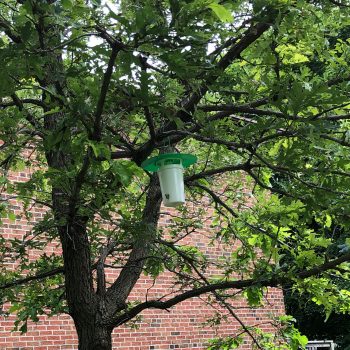
Parasitism is one of the greatest factors that contribute to the natural collapse of spongy moth populations. Since spongy moth has natural enemies that affect the insect at each stage of development, City staff monitor the level of parasitism throughout its life cycle. City staff monitor the location, prevalence and severity of parasitism in areas of the city to help predict spongy moth population levels the following spring.